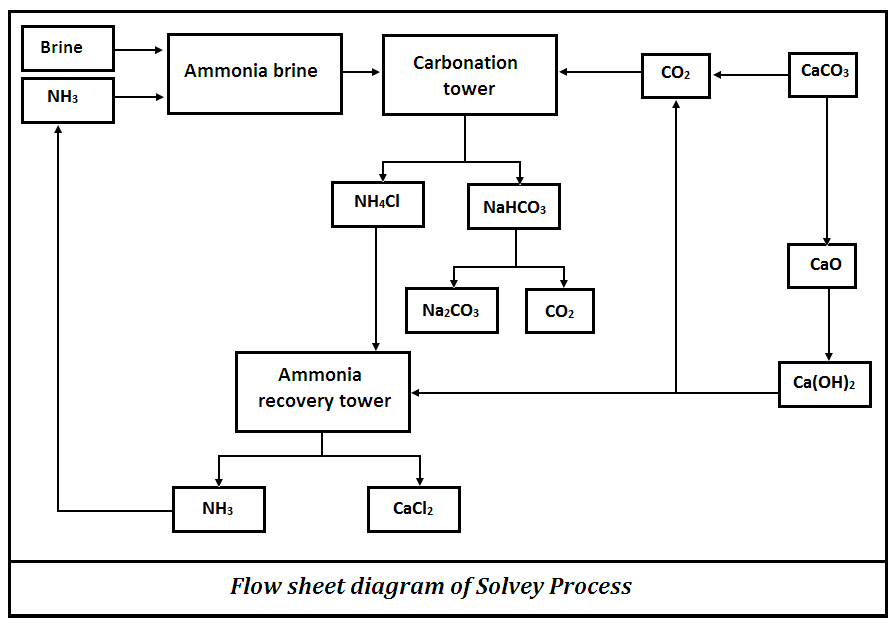Unit 16. Chemical Industries (FBISE SSC-II Chemistry Keybook)
2. Give short answers.
i. How are urea prills produced?
The urea solution is concentrated in vacuum evaporators, which is then rapidly cooled and sent to the prilling tower. Urea prills thus produced are packed and then marketed.
ii. What is slaked lime? How is it produced?
Slaked lime (Ca(OH)2 ) a white caustic alkaline substance consisting of calcium oxide, obtained by heating limestone.
Preparation of slaked lime:
Carbon dioxide is produced by heating limestone in a kiln.
Heat
CaCO3 CaO + CO2
Carbon dioxide is fed into the carbonating tower from the top. Equal amounts of lime (CaO) and water are mixed to produce slaked lime, Ca(OH)2.
CaO + H2O Ca(OH)2
- Write chemical reactions that take place during carbonation in Solvay process.
Carbonation:
In the carbonating tower, carbon dioxide is passed through ammonical brine. Following reaction takes place in it.
CO2 + NH3 + H2O NH4HCO3
NH4HCO3 + NaCl NaHCO3 + NH4Cl
15°C
In the lower compartments of carbonating tower, the temperature of the mixture is lowered to 15°C. At this temperature, NaHC03 precipitates out.
- Explain the process “Roasting” with two examples.
Some minerals are converted to oxide by heating in the air at temperature below their melting point. This process is called roasting. For example, the roasting for zinc blende (ZnS) is:
Heat
2ZnS + 3O2 2ZnO + 2SO2
Roasting reaction for cinnabar (HgS) is:
Heat
HgS + O2 Hg + SO2
Roasting reaction of copper pyrite ore is:
Heat
2CuFeS2 + O2 Cu2S + 2FeS + SO2
- Write chemical reactions that take place during urea formation.
Raw materials for the manufacture of urea:
i. Ammonia (NH3)
ii. Carbon dioxide (CO2)
Manufacturing of urea consists of following steps.
a. Reaction between NH3 and CO2 to form ammonium carbonate.
NH3 + CO2 NH2CONH4 + H2O
b. Distillation of ammonium carbonate.
NH2CONH4 
c. Evaporation of liquid urea and its granulation.
The urea solution is concentrated in vacuum evaporators, which is then rapidly cooled and sent to the prilling tower. Urea prills thus produced are packed and then marketed.
3. Describe following with an example.
a. Roasting:
Some minerals are converted to oxide by heating in the air at temperature below their melting point. This process is called roasting. For example, the roasting for zinc blende (ZnS) is.
2ZnS + 3O2 2ZnO + 2SO2
b. Smelting:
The method to reduce metal ions to free metal is called smelting.
The most common reducing agents are coke, carbon monoxide and hydrogen.
Example:
Fe2O3 + CO 2Fe + 3CO2
- Flotation:
- Pulverized ore is fed into a tank containing water and an oil-detergent mixture.
- The mixture is agitated with air.
- Detergents wet the mineral particles but not the silicate gangue.
- The mineral particles rise to the top of the mixture as a forth, from where they are skimmed off.
- Particles of the gangue fall down to the bottom.
- The copper ore is concentrated generally by flotation process.
4. Make a list of metallurgical operations.
Metallurgy:
The process of separating a metal from its ore and preparing it for use is known as metallurgy.
Basic Metallurgical Operations:
- Crushing, grinding or pulverizing of the ore
- Concentration of the ore
- Extraction of metal
- Refining of metal.
5. How was crude oil formed?
Origin/formation of Petroleum or crude oil:
- It is believed that petroleum was formed from organisms that lived hundreds of millions of years ago.
- Plants and animals in the seas died. Their remains piled up. Layers of sand, rock and mud buried the dead organisms.
- Over time, in the absence of air, heat and pressure of sediments and bacterial effect changed the material into dark brownish viscous liquid called petroleum. It is also called crude oil.
- The gaseous products accumulated over the petroleum, is called as natural gas.
6. State five specific products made from crude oil.
Natural gas, Butane, Propane, Gasoline, Home heating oil, Plastics, Kerosene and jet fuel, Diesel.
7. Outline basic reactions of Solvay process.
i. Preparation of ammonical brine:
Ammonical brine is prepared by dissolving ammonia gas in brine. Ammonical brine is fed into the carbonating tower.
ii. Carbonation:
In the carbonating tower, carbon dioxide is passed through ammonical brine. Following reaction takes place in it.
CO2 + NH3 + H2O NH4HC03
NH4HCO3 + NaCI NaHC03 + NH4Cl
15°C
In the lower compartments of carbonating tower, the temperature of the mixture is lowered to 15°C. At this temperature, NaHCO3 precipitates out.
iii. Filtration:
Precipitates of NaHCO3 are separated from the milky solution by filtration. It is used as baking soda.
iv. Calcinations:
Sodium hydrogen carbonate is heated to get sodium carbonate
Heat
2NaHCO3 Na2CO3 + CO2 + H2O
Carbon dioxide released is re-cycled in the process.
v. Preparation of carbon dioxide and slaked lime:
Carbon dioxide is produced by heating limestone in a kiln.
CaCO3 CaO + CO2
Carbon dioxide is fed into the carbonating tower from the top. Equal amounts of lime (CaO) and water are mixed to produce slaked lime, Ca(OH)2
CaO + H2O Ca (OH)2
Slaked lime is pumped to the ammonia recovery tower.
vi. Recovery of ammonia:
Solution congaing ammonium chloride produced in the carbonation tower is heated with slaked lime.
Heat
2NH4Cl + Ca(OH)2 2NH3 + CaCl2 + 2H2O
Almost all the ammonia is recovered in this process. It is reused in the process.
8. Draw flow sheet diagram of Solvay process.

9. Describe the composition of petroleum.
Petroleum is essentially a mixture of hydrocarbons particularly alkanes, cycloalkanes and aromatic hydrocarbons. Apart from hydrocarbons it may also contain compounds containing oxygen and nitrogen.
10. Make a list of raw materials for Solvay process.
Raw Materials:
- Ammonia
- Brine (concentrated sodium chloride solution)
- Lime stone as a source of carbon dioxide and slaked lime, Ca(OH)2
11. Describe the composition of petroleum.
Petroleum is essentially a mixture of hydrocarbons particularly alkanes, cycloalkanes and aromatic hydrocarbons. Apart from hydrocarbons it may also contain compounds containing oxygen and nitrogen.
12. Relate the study of chemistry to careers in industry.
- Chemists have opportunities in all the field of chemistry. For instance, organic chemists have good opportunities to work in industries like petroleum, petrochemical and pharmaceutical.
- They can research on new products, more effective medicines, new pesticides for better crops, new ways to help people reduce environmental pollution etc.
- As a food chemist; you can work in food processing industry.
- We can discover new methods to store, improve texture and flavour of foods.
- In hospitals, chemists analyse blood, urine and stood samples to detect any disease, disease causing bacteria, virus, or other microorganisms.
13. Draw flow sheet diagram of manufacture of urea.

14. Petroleum is a mixture of several compounds, which are separated in a refinery.
a) What is the name of the apparatus used for this purpose?
Fractionating tower.
b) What is the name of the process used in separating crude oil?
Fractional distillation.
- Write name of the fraction that represents gases.
Liquefied petroleum gas (LPG)
- Which fractions represent liquids with the lowest boiling points?
Petrol (350C – 700C)
15. Petroleum is a source of fuels. Name two fuels which are not obtain from petroleum.
There are several types, such as hydrogen fuel (for automotive uses), ethanol, and biodiesel, which are also categorized as a liquid fuel.
16. What has to be done to crude oil before it is useful?
Crude oil is a mixture of hydrocarbons. These are separated into useful products, such as fuels, using a process called fractional distillation in fractionating tower.
17. The table below lists some petroleum fractions with their approximate boiling points.
|
Fraction |
Approximate Boiling Point/0C |
|
P |
Below 20 |
|
Q |
35 – 70 |
|
R |
170 – 250 |
|
S |
350 – 500 |
- Name the process by which the fractions are obtained from petroleum?
Refining
- Which fraction will contain the shortest chain molecules?
Fraction P, Liquefied petroleum gas (LPG)
- Which fraction will contain the longest chain molecules?
Fraction S, lubricating oil.
- In what state will fraction P be at room temperature and pressure?
Gas
18. Should fossil fuels be burned to provide energy, or should they be used to make useful products like drugs, plastics and chemicals?
Hemp oil or hemp-seed oil is obtained by pressing hemp seeds can be used to create biofuels to replace gasoline for diesel engines. Unlike fossil fuels, biofuels are renewable and produce less of the greenhouse gas carbon monoxide. Therefore fossil fuels should be used to make useful products like drugs, plastics and chemicals.

Recent Comments